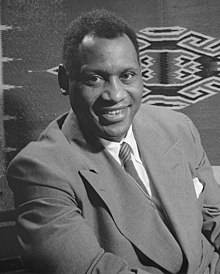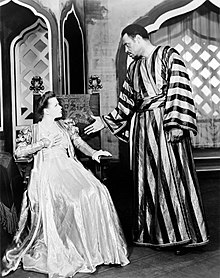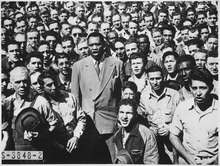Paul Robeson
| Paul Robeson | |||
 | |||
| Fødd | 9. april 1898 | ||
|---|---|---|---|
| Fødestad | Princeton | ||
| Død | 23. januar 1976 (77 år) | ||
| Dødsstad | Philadelphia | ||
| Opphav | USA | ||
| Aktiv | 1925–1963 | ||
| Instrument | vokal | ||
| Stemmetype | bassbaryton | ||
| Plateselskap | Columbia Records, Philips Records, EMI | ||
| Verka som | songar, advokat, skribent, basketballspelar, amerikansk fotball-spelar, filmskodespelar, teaterskodespelar, politikar, skodespelar, musikkforskar | ||
| Mor | Maria Louisa Bustill | ||
| Far | William Drew Robeson I | ||
| Gift med | Eslanda Goode Robeson | ||
| Sambuar med | Helen V. Rosen, Peggy Ashcroft | ||
| Born | Paul Robeson | ||
| Prisar | Spingarn-medaljen, Grammy Lifetime Achievement Award, New Jersey Hall of Fame, Stalin-prisen, Sorte filmskaperes æreshall, Paul Robeson Award, stjerne på Hollywood Walk of Fame, Donaldson Awards | ||

Paul Robeson (9. april 1898–23. januar 1976) var ein verdskjend USA-amerikansk barytonsongar og skodespelar som også markerte seg som politisk aktivist for borgarrettar og sosialisme.
Liv
Robeson var fødd i Princeton i New Jersey. Far hans, William Drew Robeson, var ein prest og rømd plantasjeslave av igbo-opphav. Mora, Maria Louisa Bustill, kom frå ein framtredande kvekarfamilie og hadde afrikansk, angloamerikansk og lenape-opphav. I 1900-01 oppstod ein konflikt mellom William og kvite støttespelarar av kyrkja hans. Konflikten førte til at han måtte gå av, og livnæra seg gjennom kroppsarbeid. Tre år seinare døydde Maria Louisa i ein husbrann. Familien måtte bu på eit leigd loft fram til William blei prest for African Methodist Episcopal Zion Church i 1910.
Paul Robeson preika av og til i staden for faren, når faren var på reise. Han deltok også i skodespel og song ved Somerville High School i Somerville i New Jersey, og gjorde det godt i amerikansk fotball, basketball, baseball og friidrett.
Utdanning
Frå 1915 studerte Robeson ved Rutgers University. Han vart den tredje afroamerikanske studenten ved universitetet nokonsinne. Under studietida utmerkte han seg som amerikansk fotballspelar og songar, og ved slutten av studiane blei han vald ut både som spelar til All America-laget (sett saman av framifrå amatørar frå heile USA) og som valedictorian - avskjedstalar - for sitt årskull.

Robeson byrja å studera juss ved New York University i 1919. Ettersom han fann seg dårleg til rette der, bytta han til Columbia University der han tok juridisk eksamen i 1922. Han arbeidde ei tid som advokat, men måtte gje seg på grunn av rasisme. Han hadde spelt i nokre stykke då han blei vald ut til å spela Jim i All God's Chillun Got Wings og Brutus i The Emperor Jones i 1923, begge stykke av den kjende dramatikaren Eugene O'Neill.
Skodespelar
Paul Robeson hadde gifta seg med Eslanda «Essie» Goode i 1921. Ho blei agenten hans, og forhandla fram den første filmrolla hans i stumfilmen Body and Soul (1925), som blei regissert av Oscar Micheaux. Robeson hadde også suksess med spiritual-framføringar saman med pianisten Lawrence Brown. I dei neste åra debuterte han som skodespelar i Europa (med The Emperor Jones) og turnerte som songar på begge sider av Atlanterhavet. Paul og Essie fekk ein son, Paul Robeson, Jr., i 1927.
Som skodespelar utmerkte Robeson seg mellom anna med rolla som Joe i musikalen Show Boat, der han la lista med si framføring av «Ol' Man River», og med tittelrolla i Othello av Shakespeare. Som songar var han særleg kjend for sine spirituals, som han spelte inn på grammofon og turnerte med i ei rekkje land.

I 1934 byrja Robeson studiar ved School of Oriental and African Studies i London. Han fekk auka interesse for Afrika og byrja engasjera seg i kampen mot imperialisme og rasisme. Robeson vitja Sovjetunionen i 1934, der han for første gong i livet følte at rase var irrelevent: «Here I am not a Negro but a human being for the first time in my life ... I walk in full human dignity.»[1]
Aktivist
Etter at andre verdskrigen braut ut heldt Robeson seg i USA, der han blei framheva som Amerikas «no.1 entertainer» og samstundes uglesett for dei politiske haldningane sine. Som ihuga borgarrettsforkjempar, støttespelar for fagforeiningar og kommunistvenleg blei han svartelista frå media.
I byrjinga av mai 1949 vitja Robeson Oslo. Etter konsertar og foredrag i Folkets Hus og i Samfundshuset, heldt han utandørskonsert på Youngstorget den 4. mai 1949. Friluftskonserten blei arrangert av avisa Friheten, hovudorganet til Norges Kommunistiske Parti.[2] Ifølge avisa hadde Robeson også tatt i mot invitasjonar frå arbeidstakarorganisasjonane ved Akers Mekaniske Verksted og ved Standard Telefon og Kabelfabrik til å møta arbeidarar ved fabrikkane. I begge tilfella skulle vitjingane skje på føremiddagen 4. mai, like utanfor fabrikkområda.[3]
I 1950 vart han fråteken passet sitt og gjeven utreiseforbod frå USA.
I 1958 blei utreiseforbod mot mistenkte kommunistar oppheva av høgsteretten i USA, og Robeson fekk passet sitt tilbake. Han la ut på ein verdsturné med London som utgangspunkt. Robeson vitja Sovjetunionen, New Zealand og Australia, der han uttalte seg kritisk mot behandlinga av maoriar og aboriginarar.
I 1961 fekk Robeson nervøst samanbrot, og gjekk gjennom behandling med elektrosjokk og medikament i London i to år. I 1963 fekk vener han overført til Aust-Berlin, der han fekk psykoterapibehandling og færre medikament. Seinare det året vende han tilbake til USA og levde hovudsakleg tilbaketrekt resten av livet.
Etter at kona Essie døydde i 1965, budde Paul nokre år med familien til sonen i New York. Deretter slo han seg ned hjå syster si i Philadelphia i 1968. Han døydde i Philadelphia, 77 år gammal.
Kjelder
- ↑ Foner 1978: 94–96 (Smith, Vern (1935-01-15). «'I am at Home,' Says Robeson at Reception in Soviet Union», Daily Worker
- ↑ «Hele Oslo møtes på Robeson-konserten i morgen kl. 19 på Youngstorget». Avisa Friheten. 3. mai 1949.
- ↑ «Paul Robeson på Aker og Standard!». Avisa Friheten. 3. mai 1949.
- Paul Robeson (10. januar 2012), Store norske leksikon. Fri artikkel henta 6. januar 2014.
- Denne artikkelen bygger på «Paul Robeson» frå Wikipedia på engelsk, den 6. januar 2014.
- Wikipedia på engelsk oppgav desse kjeldene:
Primærkjelder
- Dent, Roberta Yancy, with Marilyn Robeson and Paul Robeson, Jr. eds. Paul Robeson, Tributes, Selected Writings. New York: The Archives, 1976. OCLC 2507933.
- Foner, Philip S., ed. Paul Robeson Speaks: Writings, Speeches, Interviews, 1918–1974. Larchmont: Brunner/Mazel, 1978. ISBN 0-87630-179-0
- Robeson, Paul Leroy (1919-06-10). "The New Idealism". The Targum 50, 1918–1919: 570–1.
- Robeson, Paul; with Brown, Lloyd L. (1998). Here I Stand. (2 ed.). Boston: Beacon Press. ISBN 0-8070-6445-9
- Robeson, Paul (2000). «An Actor's Wanderings and Hopes». I Sondra Kathryn Wilson. The Messenger Reader. New York: The Modern Library. s. 292–293. ISBN 0-375-75539-X.
Biografiar
- Boyle, Sheila Tully, and Andrew Bunie (2001). Paul Robeson: The Years of Promise and Achievement. Amherst: University of Massachusetts Press. ISBN 1-55849-149-X
- Brown, Lloyd L. (1997). The Young Paul Robeson: On My Journey Now. Boulder: Westview Press. ISBN 0-8133-3178-1
- Duberman, Martin Bauml (1988). Paul Robeson. New York: New Press. ISBN 1-56584-288-X.
- Ehrlic, Scott (1988). Paul Robeson. New York. Chelsea House. ISBN 0-87067-552-4.
- Gilliam, Dorothy Butler (1976). Paul Robeson, All-American. Washington, D.C.: New Republic Books ISBN 0-915220-39-3
- Hoyt, Edwin P. (1968). Paul Robeson: The American Othello. Cleveland: The World Publishing Company.
- Ramdin, Ron (1987). Paul Robeson, The Man and His Mission. London: Peter Owen. ISBN 0-7206-0684-5
- Robeson, Eslanda (1930).Paul Robeson, Negro, London: Victor Gollancz Ltd.; 1st edition (1930) ASIN: B0006E8ML4
- Robeson Paul, Jr. (2001). The Undiscovered Paul Robeson, An Artist's Journey, 1898–1939. Wiley. eISBN 9780471151050
- Robeson Paul, Jr. (2010). The Undiscovered Paul Robeson, Quest for Freedom, 1939–1976. Wiley. ISBN 978-0-471-40973-1
- Seton, Marie (1958). Paul Robeson. London: Dennis Dobson.
Sekundærkjelder
- Balaji, Murali (2007). The Professor and the Pupil: The Politics and Friendship of W. E. B. Du Bois and Paul Robeson. New York: Nation Books ISBN 1-56858-355-9
- Beevor, Antony (2007). The Battle for Spain: The Spanish Civil War 1936–1939. London: Phoenix. ISBN 9780753821657
- Bell, Charlotte Turner (1986). Paul Robeson's Last Days in Philadelphia Bryn Mawr: Dorrance Publishing Company, Inc. ISBN 0-8059-3026-4
- Bogle, Donald (2001). Toms, Coons, Mulattoes, Mammies, and Bucks: An Interpretive History of Blacks in American Films (4 ed.). New York: Continuum. ISBN 0-8264-1267-X
- Cameron, Kenneth M. (1. oktober 1990). «Paul Robeson, Eddie Murphy, and the Film Text of 'Africa'». Text & Performance Quarterly 10 (4): 282–293. doi:10.1080/10462939009365979.
- Carroll, John M. (1992). Fritz Pollard: Pioneer in Racial Advancement. Urbana: University of Illinois Press. ISBN 0-252-01814-1
- Curthoys, Ann (2010). "Paul Robeson’s visit to Australia and Aboriginal activism, 1960" In Frances Peters-Little, Ann Curthoys and John Docker. Passionate Histories: Myth, Memory and Indigenous Australia[daud lenkje] Canberra, Australia: ANU E Press and Aboriginal History Incorporated. ISBN 978-1-921666-65-0
- Dorinson, Joseph (2002). "Something to Cheer About: Paul Robeson, Athlete" in Dorinson, Joseph; with Pencak, William, eds. (2002). Paul Robeson: Essays on His Life and Legacy. Jefferson: McFarland and Company, Inc. ISBN 0-7864-1153-8
- Eby, Cecil D. (2007). Comrades and Commissars: The Lincoln Battalion in the Spanish Civil War. University Park: Pennsylvania State University Press. ISBN 9780271029108
- Farmer, James (1985). Lay Bare The Heart: An Autobiography of the Civil Rights Movement. New York: Arbor House. ISBN 0-87795-624-3
- Finkelman, Paul (2007). "Paul Robeson" in Wintz, Cary D. ed. (2007). Harlem Speaks: A Living History of the Harlem Renaissance. Naperville: Sourcebooks. ISBN 978-1-4022-0436-4
- Foner, Henry (2001). Paul Robeson: A Century of Greatness. Paul Robeson Foundation.
- Foner, Henry (2002). "Foreword" in Dorinson, Joseph; with Pencak, William, eds. (2002). Paul Robeson: Essays on His Life and Legacy. Jefferson: McFarland and Company, Inc. ISBN 0-7864-1153-8
- Glazer, Peter (2007). "The lifted fist: performing the Spanish Civil War, New York City, 1936–1939" in Fernandez, James D., and Carroll, Peter N. (eds), Facing Fascism:New York and the Spanish Civil War. New York: Museum of the City of New York and NYU Press. ISBN 9780814716816
- Goldstein, Robert Justin (2009). American Blacklist: The Attorney General's List of Subversive Organizations. Lawrence: University Press of Kansas. ISBN 978-0-7006-1604-6
- Harris, Francis C. (1998). "Paul Robeson: An Athlete's Legacy" in Stewart, Jeffrey C. (ed.), Paul Robeson: Artist and Citizen. Rutgers University Press and The Paul Robeson Cultural Center. ISBN 0-8135-2511-X
- Hopkins, James K. (1999). Into the heart of the fire: the British in the Spanish Civil War. Stanford: Stanford University Press. ISBN 0-8047-3127-6
- James, C,L,R, (2013 [1934]) Toussaint Louverture: The Story of the Only Successful Slave Revolt in History; A Play in Three Acts Arkivert 2012-10-07 ved Wayback Machine.. Durham and London: Duke University Press. ISBN. 978-0-8223-5314-0
- Landis, Arthur H. (1967). The Abraham Lincoln Brigade. New York: Citadel Press.
- Low, Rachel (1985). Film Making in 1930s Britain. London: George Allen & Unwin. ISBN 0-04-791042-9.
- Lustiger, Arno (2003). Stalin and the Jews, The Red Book: the Tragedy of the Jewish Anti-Fascist Committee and the Soviet Jews. New York: Enigma. ISBN 1-929631-10-3
- Marable, Manning (2005), W. E. B. Du Bois: Black Radical Democrat, Paradigm Publishers, ISBN 978-1-59451-018-2
- McConnell, Lauren (2010). "Understanding Paul Robeson’s Soviet Experience", Theatre History Studies 30: 138–153.
- Morrison, Michael A. (May 2011). «Paul Robeson's Othello at the Savoy Theatre, 1930». New Theatre Quarterly 27 (2): 114–140. doi:10.1017/S0266464X11000261.
- Naison, Mark (1998). "Paul Robeson and the American Labor Movement" in Stewart, Jeffrey C. (ed.), Paul Robeson: Artist and Citizen. Rutgers University Press and The Paul Robeson Cultural Center. ISBN 0-8135-2511-X
- Nollen, Scott Allen (2010). Paul Robeson: Film Pioneer. Jefferson: McFarland and Company, Inc. ISBN 978-0-7864-3520-3
- Pellowski, Michael (2008). Rutgers Football: A Gridiron Tradition in Scarlet. New Brunswick: Rivergate Books. ISBN 9780813542836
- Peterson, Bernard L., Jr. (1997). The African American Theatre Directory, 1816–1960. Westport, CT: Greenwood Press. ISBN 0-313-29537-9
- Pitt, Larry (1969) Football at Rutgers: A History, 1869–1969. New Brunswick: Rutgers University Press. ISBN 0-8135-0747-2
- Robeson, Paul Jr. (1978). «Paul Robeson: Black Warrior». I Freedomways. Paul Robeson: The Great Forerunner. New York: Dodd, Mead & Company. s. 3–16. ISBN 0-396-07545-2.
- Richards, Jeffrey (1998). The Unknown 1930s: An Alternative History of the British Cinema 1929–39. New York: I.B. Tauris. ISBN 1-86064-303-5
- Richards, Larry (1998). African American Films through 1959: A Comprehensive, Illustrated Filmography. Jefferson, NC: McFarland. ISBN 0-7864-0307-1
- Robeson, Susan (1981). The Whole World in His Hands: A Pictorial Biography of Paul Robeson. Secaucus: Citadel Press. ISBN 0-8065-0754-3
- Robinson, Eugene (1978). «A Distant Image: Paul Robeson and Rutgers' Students». I Freedomways. Paul Robeson: The Great Forerunner. New York: Dodd, Mead & Company. s. 178–188. ISBN 0-396-07545-2.
- Robinson, Jackie and Duckett, Alfred (1972). I Never Had It Made. Hopewell: Ecco Press.
- Robinson, Robert (1988). Black on Red: A Black American's 44 Years inside the Soviet Union. Washington, D.C.: Acropolis Books. ISBN 0-87491-885-5.
- Rogovin, Vadim Z. (1998). 1937: Stalin's Year of Terror. Oak Park, MI: Mehring Books, Inc. ISBN 0-929087-77-1
- Sampson, Henry T. (2005). Swingin' on the Ether Waves: A Chronological History of African Americans in Radio and Television Programming, 1925–1955. Lanham: The Scarecrow Press, Inc. ISBN 0-8108-4087-1
- Seton, Marie (1978). «Paul Robeson on the English Stage». I Freedomways. Paul Robeson: The Great Forerunner. New York: Dodd, Mead & Company. s. 26–49. ISBN 0-396-07545-2.. A reprint of Seton 1958.
- Snyder, Timothy (2010). Bloodlands: Europe Between Hitler and Stalin. New York: Basic Books. ISBN 978-0-465-00239-9.
- Stuckey, Sterling (1994). Going Through the Storm: The Influence of African American Art in History. New York: Oxford University Press. ISBN 0-19-507677-X
- Swindall, Lindsay R. (2011). The Politics of Paul Robeson's Othello. Jackson: University Press of Mississippi. eISBN 978-1-60473-825-4
- Tuner, Lorenzo Dow (20070. Lorenzo Dow Turner: Father of Gullah Studies. University of South Carolina Press. ISBN 978-1-57003-628-6 p. 108
- Von Eschen, Penny M. (1994). Race Against Empire: African Americans and Anti-colonialism, 1937–1957. Ithaca: Cornell University Press. ISBN 0-8014-3197-2
- Walsh, Christy (1949). College Football: and All America Review. Murray & Gee.
- Weisenfeld, Judith (1997). African American Women and Christian Activism: New York's Black YWCA, 1905–1945. Cambridge: Harvard University Press. ISBN 0-674-00778-6
- Wintz, Cary D. red. (2007). Harlem Speaks: A Living History of the Harlem Renaissance. Naperville: Sourcebooks. ISBN 978-1-4022-0436-4
- Wright, Charles (1975). Paul Robeson: Labor's Forgotten Champion. Detroit: Balamp Publishing. ISBN 0-913642-06-1
- Wyden, Peter (1983). The Passionate War: A Narrative History of the Spanish Civil War, 1936–1939. New York: Simon and Schuster. ISBN 0-671-25330-1